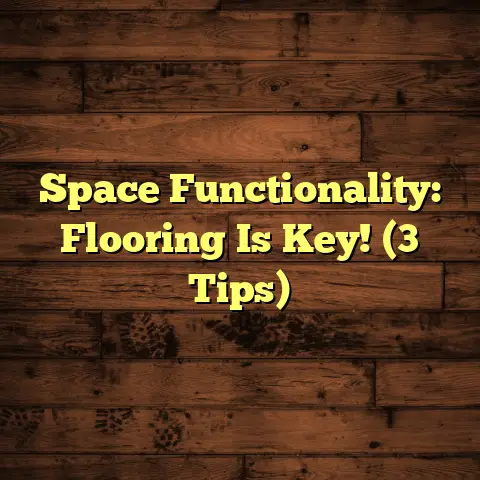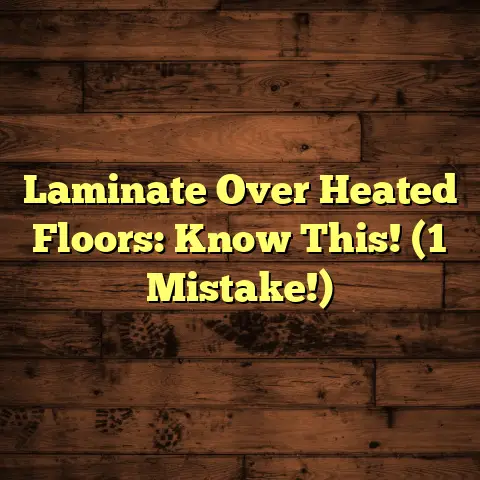Sand & Stain Wood Floors: Cost Guide? (1 Day Left!)
Wood floors are a fantastic choice for any home, bringing natural beauty and lasting value.
Plus, with the right care, they’re surprisingly easy to maintain.
In this guide, we’ll dive deep into the world of sanding and staining wood floors.
We’ll cover everything from understanding your wood, to the costs involved, and whether you should DIY or hire a pro.
So, let’s get started and unlock the potential of your wood floors!
1. Understanding Wood Flooring
So, what exactly is wood flooring?
Simply put, it’s flooring made from wood! But there’s more to it than that. We have different types:
-
Solid Wood: This is the real deal – planks milled from a single piece of wood. It’s durable, can be sanded and refinished multiple times, and adds significant value to your home. Think oak, maple, or cherry.
-
Engineered Wood: This consists of a thin layer of hardwood veneer bonded to a core of plywood or high-density fiberboard (HDF). It’s more stable than solid wood, especially in areas with high humidity, and often more affordable.
-
Laminate: While it looks like wood, laminate is actually a synthetic material made to mimic the appearance of wood. It’s budget-friendly and easy to install, but it doesn’t have the same longevity or resale value as real wood.
Why Choose Wood?
Wood flooring offers a ton of benefits:
-
Durability: With proper care, wood floors can last for decades, even centuries!
-
Aesthetics: Wood adds a natural warmth and elegance that’s hard to replicate.
-
Resale Value: Homes with hardwood floors tend to sell for more.
-
Versatility: Wood can be stained in a variety of colors to match any décor.
The Wood Floor Lifecycle
Like anything, wood floors aren’t immune to wear and tear.
Over time, they can get scratched, scuffed, and faded.
That’s where sanding and staining come in.
Sanding removes the old finish and imperfections, while staining adds a fresh color and protects the wood.
It’s like giving your floors a brand-new lease on life!
2. The Sanding Process
Let’s talk sanding!
Sanding is essential for prepping your wood floors for a new finish.
It removes old stain, scratches, and imperfections, creating a smooth, even surface for the stain to adhere to.
Think of it as prepping a canvas before painting.
Sanding Methods: Manual vs. Machine
You have two main options:
-
Manual Sanding: This involves using sandpaper and elbow grease. It’s suitable for small areas or detail work, but it’s time-consuming and physically demanding for larger floors.
-
Machine Sanding: This uses specialized sanding machines, like drum sanders and orbital sanders. It’s much faster and more efficient for larger areas, but it requires some skill to operate properly.
Step-by-Step Guide to Sanding
Alright, let’s get into the nitty-gritty. Here’s how to sand your wood floors:
- Preparation:
- Clear the room completely. Remove all furniture, rugs, and anything else in the way.
- Protect yourself. Wear safety glasses, a dust mask, and ear protection.
- Seal off doorways with plastic sheeting to contain the dust.
- Sanding:
- Start with a coarse grit sandpaper (e.g., 36-grit) to remove the old finish and level the floor.
- Work your way up to finer grits (e.g., 60-grit, 80-grit, 100-grit) to smooth the surface.
- Overlap each pass slightly to ensure even sanding.
- Pay attention to edges and corners, using an edge sander or hand sanding.
- Cleaning Up:
- Vacuum the floor thoroughly to remove all dust.
- Wipe the floor with a tack cloth to pick up any remaining dust particles.
Safety First!
Sanding creates a lot of dust, which can be harmful to your lungs.
Always wear a dust mask or respirator, and ensure good ventilation in the room.
Eye protection and ear protection are also essential.
3. The Staining Process
Now for the fun part: staining!
Staining adds color and enhances the natural beauty of your wood floors.
It also helps protect the wood from moisture and wear.
Types of Stains
There are several types of stains to choose from:
-
Oil-Based Stains: These penetrate deeply into the wood, providing rich color and good durability. They tend to dry slower and have a stronger odor than water-based stains.
-
Water-Based Stains: These are low in VOCs (volatile organic compounds), making them a more environmentally friendly choice. They dry quickly and have a less pungent odor, but may not penetrate as deeply as oil-based stains.
-
Gel Stains: These are thicker and more viscous than other stains, making them ideal for vertical surfaces or woods that don’t readily absorb stain.
Step-by-Step Guide to Staining
Here’s how to stain your wood floors:
- Preparation:
- Make sure the floor is clean, dry, and free of dust.
- Test the stain on an inconspicuous area to ensure you like the color.
- Gather your supplies: stain, applicator (brush, rag, or pad), gloves, and a container for the stain.
- Application:
- Apply the stain evenly, following the grain of the wood.
- Work in small sections to avoid lap marks.
- Allow the stain to sit for the recommended amount of time (check the manufacturer’s instructions).
- Wipe off any excess stain with a clean rag.
- Drying:
- Allow the stain to dry completely before applying a finish.
- Drying times vary depending on the type of stain and the humidity.
Choosing the Right Color
The stain color can dramatically change the look of your floors.
Consider the overall style of your home and the existing furniture and décor.
Lighter stains can brighten up a room, while darker stains add drama and sophistication.
I often advise clients to get samples of a few different colors and test them on a small, hidden area of the floor.
This will give you a better idea of how the stain will look on your specific wood.
4. Cost Factors for Sanding and Staining Wood Floors
Okay, let’s talk money.
The cost of sanding and staining wood floors can vary significantly depending on several factors.
Breaking Down the Costs
Here’s a breakdown of the main cost components:
-
Labor Costs: If you’re hiring professionals, labor will be the biggest expense. Expect to pay anywhere from \$3 to \$8 per square foot, depending on the complexity of the job and the experience of the contractor.
-
Material Costs: This includes the cost of sandpaper, stain, sealers, and other supplies. The type of stain you choose will also affect the cost. Oil-based stains tend to be more expensive than water-based stains.
-
Tools and Equipment: If you’re DIYing, you’ll need to rent or purchase sanding equipment. A drum sander can cost around \$50 to \$100 per day to rent. You’ll also need to factor in the cost of edgers, sanders and other tools.
I have seen some homeowners try to cut corners by using cheaper materials or skipping steps, but this can often lead to problems down the road.
It’s usually better to invest in quality materials and do the job right the first time.
Regional Variations
Pricing can also vary depending on your location.
Labor costs tend to be higher in urban areas than in rural areas.
The availability of certain materials can also affect the cost.
For example, if you live in an area where a particular type of wood is scarce, it may be more expensive to purchase.
Here’s a table illustrating potential cost variations across different regions in the US (these are estimates and can vary widely):
| Region | Average Labor Cost (per sq ft) | Average Material Cost (per sq ft) | Total Estimated Cost (500 sq ft) |
|---|---|---|---|
| Northeast | \$6 – \$10 | \$2 – \$4 | \$4,000 – \$7,000 |
| Midwest | \$4 – \$7 | \$1.50 – \$3.50 | \$2,750 – \$5,250 |
| South | \$3 – \$6 | \$1.50 – \$3 | \$2,250 – \$4,500 |
| West | \$5 – \$9 | \$2.50 – \$4.50 | \$3,750 – \$6,750 |
Source: Based on industry averages and regional cost of living data.
Note: These are estimates. It’s always best to get multiple quotes from local contractors for an accurate assessment.
5. DIY vs. Professional Services
Now for the big question: should you tackle this project yourself, or hire a professional?
DIY: Pros and Cons
Pros:
- Cost Savings: You’ll save money on labor costs.
- Control: You have complete control over the process.
- Satisfaction: You’ll get a sense of accomplishment from doing it yourself.
Cons:
- Time Commitment: It can take a significant amount of time, especially if you’re not experienced.
- Skill Required: Sanding and staining require some skill to do properly.
- Potential Mistakes: Mistakes can be costly and time-consuming to fix.
Professional Services: Pros and Cons
Pros:
- Expertise: Professionals have the knowledge and experience to do the job right.
- Efficiency: They can complete the project much faster than you could.
- Guaranteed Results: Most professionals offer a warranty or guarantee on their work.
Cons:
- Higher Cost: You’ll pay more for labor.
- Less Control: You’ll need to trust the professional to make decisions.
Choosing a Professional
If you decide to hire a professional, here are some tips:
- Get Multiple Quotes: Compare prices from different contractors.
- Check References: Ask for references and follow up with them.
- Verify Credentials: Make sure the contractor is licensed and insured.
- Read Reviews: Check online reviews to see what other customers have to say.
- Ask Questions: Don’t be afraid to ask questions about their process, materials, and warranty.
I always encourage homeowners to do their research and choose a contractor they feel comfortable with.
A good contractor will be transparent about their pricing, process, and warranty.
They should also be willing to answer any questions you have and address any concerns you may have.
6. Maintenance After Sanding and Staining
You’ve sanded and stained your floors – congratulations!
But the job isn’t over yet. Proper maintenance is essential to keep your floors looking their best for years to come.
Cleaning Methods
- Regular Sweeping or Vacuuming: This will remove dirt and debris that can scratch the finish.
- Damp Mopping: Use a damp mop and a pH-neutral wood floor cleaner. Avoid using excessive water, as this can damage the wood.
- Avoid Harsh Chemicals: Don’t use abrasive cleaners, bleach, or ammonia, as these can dull the finish.
Periodic Maintenance
- Screening and Recoating: Every few years, you may need to screen and recoat your floors to refresh the finish. This involves lightly sanding the surface and applying a new coat of polyurethane.
- Professional Cleaning: Consider hiring a professional cleaning service to deep clean your floors every few years.
Preventing Wear and Tear
- Use Rugs and Mats: Place rugs and mats in high-traffic areas to protect the floors from wear and tear.
- Use Furniture Pads: Place felt pads under furniture legs to prevent scratches.
- Avoid High Heels: High heels can dent and scratch wood floors.
- Clean Up Spills Immediately: Wipe up spills as soon as they happen to prevent staining.
Here’s a quick maintenance checklist:
- Daily: Sweep or vacuum to remove dirt and debris.
- Weekly: Damp mop with a pH-neutral wood floor cleaner.
- Monthly: Inspect for scratches and wear.
- Annually: Consider a professional cleaning.
- Every 3-5 Years: Screen and recoat the finish.
7. Conclusion
Sanding and staining wood floors is a worthwhile investment that can significantly enhance the beauty and value of your home.
While the process can seem daunting, with the right knowledge and preparation, it can be a rewarding experience.
Whether you choose to DIY or hire a professional, remember to focus on quality materials, proper techniques, and ongoing maintenance.
By taking these steps, you can ensure that your wood floors will look beautiful and last for generations.
Call to Action
So, take a good look at your wood floors.
Are they looking a little tired or worn?
Is it time for a refresh?
Don’t wait until the damage is irreversible.
Taking action now can save you money and headaches in the long run.
Whether you decide to tackle the project yourself or hire a professional, sanding and staining your wood floors is a great way to enhance the beauty and value of your home.





